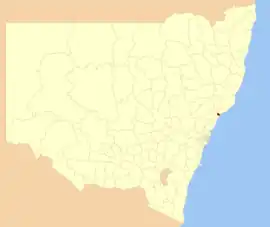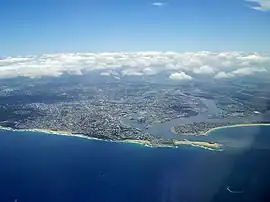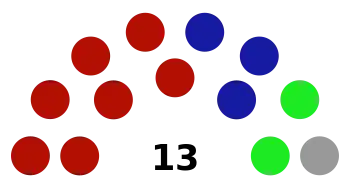City of Newcastle
The City of Newcastle is a local government area in the Hunter region of New South Wales, Australia. The City of Newcastle incorporates much of the area of the Newcastle metropolitan area.
| City of Newcastle New South Wales | |||||||||||||||
|---|---|---|---|---|---|---|---|---|---|---|---|---|---|---|---|
 Location in New South Wales | |||||||||||||||
 Aerial view of Newcastle | |||||||||||||||
| Coordinates | 32°55.7′S 151°46.9′E | ||||||||||||||
| Population | 168,873 (2021 census)[1] (39th) | ||||||||||||||
| • Density | 862.2/km2 (2,233/sq mi) | ||||||||||||||
| Area | 187 km2 (72.2 sq mi)[2] | ||||||||||||||
| Time zone | AEST (UTC+10) | ||||||||||||||
| • Summer (DST) | AEDT (UTC+11) | ||||||||||||||
| Lord Mayor | Nuatali Nelmes (Labor)[3] | ||||||||||||||
| Location | 162 km (101 mi) NNE of Sydney | ||||||||||||||
| Council seat | 12 Stewart Avenue, Newcastle | ||||||||||||||
| Region | Hunter[4] | ||||||||||||||
| County | Northumberland | ||||||||||||||
| State electorate(s) | |||||||||||||||
| Federal division(s) | |||||||||||||||
 | |||||||||||||||
| Website | City of Newcastle | ||||||||||||||
| |||||||||||||||
The Lord Mayor of City of Newcastle Council is Councillor Nuatali Nelmes, a Labor politician.[3] Nelmes was elected at a by-election on 15 November 2014 following the resignation of Jeff McCloy, the former Lord Mayor.[10] The Awabakal and Worimi peoples are acknowledged by council as the traditional custodians of the land and waters of Newcastle.[11]
History
Following the passing of the Municipalities Act 1858 by the New South Wales parliament, the Municipality of Newcastle was proclaimed on 7 June 1859. The new Municipality was divided into three wards – City, Macquarie, and Honeysuckle.[12] Eight years later, the Municipalities Act 1867 classified the Newcastle Municipality as a "Borough".[13]
The Greater Newcastle Act 1937 merged the City of Newcastle with 10 of its suburban municipalities to form the City of Greater Newcastle. The Act also transferred parts of the Lake Macquarie Shire and Tarro Shire to the new city.[14] The amalgamations and transfers took effect from 2 April 1938.[15]
The newly created City of Greater Newcastle was subsequently renamed to City of Newcastle on 23 March 1949.[16]
| Municipality | Date established | Population[17] | |||
| 1891 | 1901 | 1911 | 1921 | ||
| Adamstown | 31 December 1885 | 2,030 | 2,420 | 2,660 | 3,959 |
| Carrington | 28 March 1887 | 2,137 | 2,547 | 2,685 | 3,115 |
| Hamilton | 11 December 1871 | 4,844 | 6,124 | 7,908 | 14,196 |
| Lambton | 26 June 1871 | 3,436 | 3,159 | 2,796 | 3,691 |
| Merewether | 20 August 1885 | 4,399 | 4,547 | 4,151 | 5,908 |
| New Lambton | 1 August 1889 | 1,548 | 1,578 | 1,827 | 3,550 |
| Stockton | 12 October 1889 | 2,417 | 2,549 | 2,106 | 4,598 |
| Wallsend | 27 February 1874 | 6,945 | 6,997 | 6,007 | 6,446 |
| Waratah | 23 February 1871 | 2,718 | 3,080 | 4,419 | 12,192 |
| Wickham | 25 February 1871 | 6,582 | 7,752 | 8,434 | 12,151 |
Proposed amalgamation
After a 2015 review by the NSW Government Independent Pricing and Regulatory Tribunal found that Newcastle City Council was not "fit for the future", it was recommended that the City of Newcastle merge with Lake Macquarie City Council.[18] However, the Minister for Local Government subsequently proposed that Newcastle City Council instead merge with Port Stephens Council to form a new council with an area of 1,045 km2 (403 sq mi) and support a population of approximately 230,000.[19] The outcome of an independent review was completed by mid–2016. On 14 February 2017, the NSW Government announced it would not be proceeding with further regional council mergers, including the Newcastle City Council and Port Stephens Council merger.[20]
Demographics
At the 2016 census, there were 155,411 people in the City of Newcastle local government area, of these 49.3 per cent were male and 50.7 per cent were female. Aboriginal and Torres Strait Islander people made up 3.5 per cent of the population, which was higher than the national and state averages of 2.9 and 2.9 per cent. The median age of people in the City of Newcastle was 37 years, just below the national median of 38. Children aged 0 – 14 years made up 16.9 per cent of the population and people aged 65 years and over made up 16 per cent of the population. Of people in the area aged 15 years and over, 40.7 per cent were married and 15.4 per cent were either divorced or separated.[1]
Population growth in the City of Newcastle between the 2001 census and the 2006 census was 3.91 per cent; and in the subsequent ten years to the 2016 census, population growth was 9.64 per cent. When compared with total population growth of Australia for the same periods, being 5.78 per cent and 17.86 per cent respectively, population growth in the City of Newcastle local government area was significantly lower than the national average.[21][22][1] The median weekly income for residents within the City of Newcastle was marginally lower than the national average.[1]
At the 2016 census, over 80% of residents in the City of Newcastle local government area stated their country of birth as Australia significantly exceeding the national average of 66.7%. Almost 60% of all residents in the City of Newcastle nominated a religion with Catholicism being at almost 25%, which was slightly higher than the national average of 22.6%. As at the 2016 census, households in the City of Newcastle local government area had a significantly lower than average proportion (11.6%) where a language other than English is spoken (national average was 22.2%).[1]
| Selected historical census data for the City of Newcastle local government area | ||||||
|---|---|---|---|---|---|---|
| Census year | 2001[21] | 2006[22] | 2011[2] | 2016[1] | ||
| Population | Estimated residents on Census night | 136,413 | 141,753 | 148,535 | 155,411 | |
| LGA rank in terms of size within New South Wales | 18th | |||||
| % of New South Wales population | 2.15% | |||||
| % of Australian population | 0.73% | |||||
| Cultural and language diversity | ||||||
| Ancestry, top responses | English | 29.2% | ||||
| Australian | 30.4% | |||||
| Irish | 8.9% | |||||
| Scottish | 8.0% | |||||
| German | 2.9% | |||||
| Language, top responses (other than English) | Mandarin | n/c | ||||
| Macedonian | 1.1% | |||||
| Italian | 0.9% | |||||
| Greek | 0.7% | |||||
| Arabic | n/c | |||||
| Religious affiliation | ||||||
| Religious affiliation, top responses | No Religion | 12.7% | ||||
| Catholic | 26.6% | |||||
| Anglican | 27.0% | |||||
| Uniting Church | 8.2% | |||||
| Presbyterian and Reformed | 4.1% | |||||
| Median weekly incomes | ||||||
| Personal income | Median weekly personal income | A$409 | A$563 | A$660 | ||
| % of Australian median income | 87.8% | |||||
| Family income | Median weekly family income | A$1,132 | A$1,530 | A$1,778 | ||
| % of Australian median income | 96.7% | |||||
| Household income | Median weekly household income | A$885 | A$1,165 | A$1,368 | ||
| % of Australian median income | 86.2% | |||||
| Dwelling structure | ||||||
| Dwelling type | Separate house | 74.6% | ||||
| Semi-detached, terrace or townhouse | 10.0% | |||||
| Flat or apartment | 14.1% | |||||
Council
Current composition and election method
Newcastle City Council is composed of thirteen councillors, including the Lord Mayor, generally for a fixed four-year term of office. The Lord Mayor is directly elected while the twelve other Councillors are elected proportionally as four separate wards, each electing three Councillors. The most recent election was held in September 2021.[10][23][24][25][26] The Lord Mayor elected at that time, Jeff McCloy, resigned in 2014, and a by-election for Lord Mayor was held on 15 November 2014. The current makeup of the council, including the Lord Mayor, is as follows:

| Party | Councillors | |
|---|---|---|
| Labor Party | 7 | |
| Liberal Party | 3 | |
| Independents | 1 | |
| The Greens | 2 | |
| Total | 13 | |
The current Council, elected in September 2021, in order of election by ward is:
| Ward | Councillor | Party | Notes | |
|---|---|---|---|---|
| Lord Mayor | Nuatali Nelmes | Labor | ||
| Ward One | Declan Clausen | Labor | ||
| John MacKenzie | Greens | |||
| John Church | Independent | |||
| Ward Two | Jenny Barrie | Liberal | ||
| Carol Duncan | Labor | |||
| Charlotte McCabe | Greens | |||
| Ward Three | Peta Winney-Baartz | Labor | ||
| Katrina Wark | Liberal | |||
| Margaret Wood | Labor | |||
| Ward Four | Deahnna Richardson | Labor | ||
| Elizabeth Adamczyk | Labor | |||
| Callum Pull | Liberal | |||
Sister cities
Newcastle Council has sister city relations with the following cities:
| City | Prefecture/State | Country | Year |
|---|---|---|---|
| Ube | 1980 | ||
| Dubbo | 1995 | ||
| Arcadia |
Coat of arms
|
References
- Docherty, James (1977). The Second City: Social and Urban Change in Newcastle, New South Wales 1900 – c. 1929 (PDF) (Thesis). Australian National University. Retrieved 30 November 2018.
Notes
- Australian Bureau of Statistics (27 June 2017). "Newcastle (C)". 2016 Census QuickStats. Retrieved 16 November 2017.
- Australian Bureau of Statistics (31 October 2012). "Newcastle (Local Government Area)". 2011 Census QuickStats. Retrieved 10 September 2012.
- "New mayor Labor's Nuatali Nelmes cruises to victory". Newcastle Herald. 15 November 2014. Retrieved 16 November 2014.
- "Suburb Search – Local Council Boundaries – Hunter (HT) – Newcastle City Council". New South Wales Division of Local Government. Archived from the original on 26 March 2011. Retrieved 10 October 2012.
- "Newcastle". New South Wales Electoral Commission. Retrieved 23 November 2019.
- "Wallsend". New South Wales Electoral Commission. Retrieved 23 November 2019.
- "Charlestown". New South Wales Electoral Commission. Retrieved 23 November 2019.
- "Port Stephens". New South Wales Electoral Commission. Retrieved 23 November 2019.
- "Newcastle". Australian Electoral Commission. 26 July 2012. Archived from the original on 21 May 2011. Retrieved 10 October 2012.
- "Mayor Tally Sheet" (PDF). Newcastle City Council Election 2012. Australian Election Company. September 2012. Retrieved 3 October 2012.
- "Aboriginal Culture, City of Newcastle, Australia". Retrieved 2 September 2020.
- "Municipality of Newcastle – Proclamation (105)". Government Gazette of the State of New South Wales. 8 June 1859. p. 1293. Retrieved 2 December 2018 – via National Library of Australia.
- Municipalities Act 1867 (NSW)
- Greater Newcastle Act 1937 (NSW)
- "Greater Newcastle Act 1937 – Proclamation (5)". Government Gazette of the State of New South Wales. 14 January 1938. p. 82. Retrieved 29 November 2018 – via National Library of Australia.
- "Local Government Act 1919 – Proclamation (55)". Government Gazette of the State of New South Wales. 1 April 1949. p. 990. Retrieved 29 November 2018 – via National Library of Australia.
- Docherty, p. 299
- "Four Hunter councils deemed 'unfit for future'". ABC News. 20 October 2015. Retrieved 13 March 2016.
- "Merger proposal: Newcastle City Council, Port Stephens Council" (PDF). Government of New South Wales. January 2016. p. 8. Retrieved 13 March 2016.
- "Stronger Councils Stronger Communities". Government of New South Wales. 14 February 2017. Retrieved 22 February 2017.
- Australian Bureau of Statistics (9 March 2006). "Newcastle (C)". 2001 Census QuickStats. Retrieved 23 December 2013.
- Australian Bureau of Statistics (25 October 2007). "Newcastle (C)". 2006 Census QuickStats. Retrieved 23 December 2013.
- "Final Result in Order of Standing: Ward One" (PDF). Newcastle City Council Election 2012. Australian Election Company. 21 September 2012. p. 24. Retrieved 3 October 2012.
- "Final Result in Order of Standing: Ward Two" (PDF). Newcastle City Council Election 2012. Australian Election Company. 21 September 2012. p. 24. Retrieved 3 October 2012.
- "Final Result in Order of Standing: Ward Three" (PDF). Newcastle City Council Election 2012. Australian Election Company. 20 September 2012. p. 22. Retrieved 3 October 2012.
- "Final Result in Order of Standing: Ward Four" (PDF). Newcastle City Council Election 2012. Australian Election Company. 21 September 2012. p. 24. Retrieved 3 October 2012.
- Low, Charles (1971). A Roll of Australian Arms. Adelaide: Rigby Limited. pp. 17–18. ISBN 0-85179-149-2.
- "Council History". City of Newcastle. Retrieved 8 October 2023.
- "NEWCASTLE COUNCIL". Newcastle Morning Herald And Miners' Advocate. Newcastle, New South Wales, Australia. 8 February 1921. p. 5. Retrieved 8 October 2023 – via National Library of Australia.
- "A CITY". The Newcastle Sun. Newcastle, New South Wales, Australia. 8 February 1921. p. 5. Retrieved 8 October 2023 – via National Library of Australia.
- ""The End Crowns the Work"". Newcastle Morning Herald And Miners' Advocate. Newcastle, New South Wales, Australia. 1 March 1945. p. 3. Retrieved 8 October 2023 – via National Library of Australia.
- "Identity Badges For Aldermen". Newcastle Morning Herald And Miners' Advocate. Newcastle, New South Wales, Australia. 17 September 1952. p. 2. Retrieved 8 October 2023 – via National Library of Australia.
- "£160 Cost To "Register" Council Crest". Newcastle Morning Herald And Miners' Advocate. Newcastle, New South Wales, Australia. 5 July 1947. p. 5. Retrieved 8 October 2023 – via National Library of Australia.
